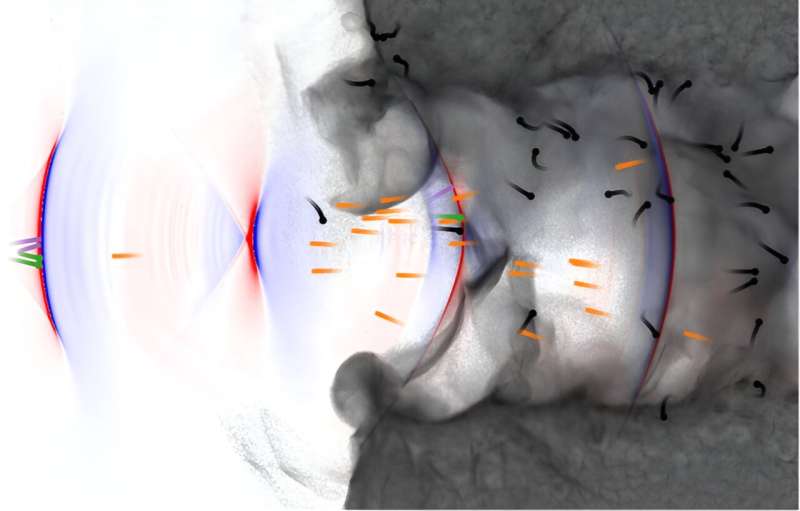Simulation of the interaction between a Doppler-boosted laser and a solid target. Credit: Zaïm et al.
The experimental generation of increasingly intense light beams could help to unveil new physical regimes occurring in the presence of very strong electromagnetic fields. While some progress has been made towards this goal, physicists are yet to develop a reliable strategy to achieve extreme light intensities.
Researchers at LIDYL, CEA, CNRS, Université Paris-Saclay recently proposed a realistic method to reach unprecedented light intensities in experimental settings, using tightly focused doppler-boosted lasers. This method, outlined in a paper published in Physical Review Letters, was theoretically found to enable light-matter interactions near the Schwinger limit.
"The paper exploits an idea that emerged in our team at France's Alternative Energies and Atomic Energy Commission (CEA-LIDYL) in 2019 and that has been extensively studied since then in collaboration with the Lawrence Berkeley National Laboratory (especially regarding the modeling aspects)," Henri Vincenti and Neil Zaim, co-authors of the paper, told Phys.org.
"Within this collaboration, we are devising a new technique to produce a light source at an unprecedented intensity and researching how such a light source could be used to explore the strong field regime of quantum electrodynamics (SF-QED)."
QED, the relativistic quantum theory of electrodynamics, is among one of the most accurately tested physics theories. Its strong-field regime, however, remains largely unexplored, due to current difficulties in probing it experimentally.
"The theory of SF-QED has been developed decades ago and predicts the emergence of new physical regimes in the presence of very strong electromagnetic fields, where gamma-ray emission and antimatter (electron-positron pairs) production are prevalent and where even light propagation in vacuum becomes nonlinear," Vincenti and Zaim said.
"For instance, an intense light beam can modify the propagation of another light beam crossing its path, a regime not described by Maxwell's equations that are linear by essence."
Strong field regimes are theorized to occur in the vicinity of massive astrophysical objects, including black holes and neutron stars, as well as during extreme astrophysical events, such as gamma-ray bursts. These cosmological phenomena are not yet fully understood, thus studying the extreme regimes associated with them in laboratory settings could prove highly insightful.
Until now, however, scientists have been unable to successfully reproduce SF-QED dominated regimes in experimental settings. The few experiments that attempted to do so relied on large-scale particle accelerators, yet they could only detect a small number of SF-QED processes.
"These regimes are challenging to reproduce in a laboratory setting because SF-QED phenomena occur when electromagnetic fields approach the so-called Schwinger limit (~1018 V/m or equivalently ~1029 W/cm2); orders of magnitude above state-of-the-art laser technology, which can 'only' produce intensities up to ~1023 W/cm2," Vincenti and Zaim said.
More information: Neïl Zaïm et al, Light-Matter Interaction near the Schwinger Limit Using Tightly Focused Doppler-Boosted Lasers, Physical Review Letters (2024). DOI: 10.1103/PhysRevLett.132.175002. On arXiv: DOI: 10.48550/arxiv.2303.17581
Journal information: Nature Physics , Physical Review Letters , arXiv
© 2024 Science X Network
























